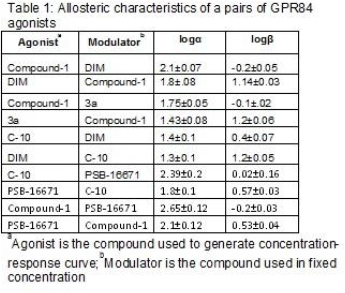Print version
Search Pub Med
| 013P Nottingham, UK 7th Focused Meeting on Cell Signalling |
Allosteric modulation of the orphan G-protein coupled receptor GPR84
Introduction: G protein-coupled receptor 84 (GPR84), is attracting interest as a target for the development of therapies to treat chronic inflammation-associated diseases [1]. However, GPR84 still remains poorly characterized and details of the mode of action of pharmacological tools are limited. There is a growing interest in allosteric modulation of GPCRs that might be exploited for the development of more selective and safer drug candidates. We have performed detailed studies of allosteric interactions of 3,3′-diindolylmethane (DIM) and DIM analogues 5,5′-dimethoxy-3,3′-diindolylmethane (3a) and di(5,7-difluoro-1H-indole-3-yl)methane (PSB-16671) with a pair of orthosteric agonists of hGPR84, decanoic acid and compound 1.
Method: [35S]-GTPγS binding assays were performed according to [2] using membranes expressing a FLAG-human GPR84-Gαi2 fusion protein. Data were analysed using an operational model of allosteric modulation described previously [3]. Data represent mean ± SEM for three independent experiments.
Results: Increasing fixed concentrations of DIM progressively increased the potency of both decanoic acid and compound-1 yielding affinity co-operativity factors, α, of 25.4±1.2 and 126±1.2, respectively. This indicates that DIM acts as a potent PAM-agonist. In reciprocal experiments, increasing concentrations of decanoic acid and compound-1 enhanced the potency and efficacy of DIM with α value of 20±1.2 and 63±1.1 respectively (Table 1). DIM analogue 3a also enhanced the potency of compound-1 with α value of 56±1.1 indicating that 3a is also a PAM-agonist. DIM analogue PSB-16671 was the most effective PAM of potency of decanoic acid and compound-1 with α value of 245±1.5 and 452±1.3, respectively. Estimates of affinity from these analyses indicated PSB-16671 to bind human GPR84 with 5 fold higher affinity than DIM.
Conclusions: DIM, analogue 3a and particularly PSB-16671 are highly effective positive allosteric modulators of a pair of orthosteric GPR84 agonists.
References:
1. Liu Y et al. (2016). ACS Med Chem Lett 7: 579-583.
2. Hudson BD et al. (2014). Mol Pharmacol 86: 200-210.
3. Ehlert FJ (2005). J Pharm Exp Ther 315: 740-754.



